Korean cuisine is one of the finest in the world. It’s so good that UNESCO have acknowledged it. We have recently returned from a trip to this amazing country. We wanted to try as much local food as possible so ate at a variety of restaurants as well as spent time discovering the vibrant street food scene. Korean people are passionate about their cuisine. We also enjoyed learning about the importance of the Korean table setting. Here’s our guide to dining and etiquette in Korea.
Please note that this post contains affiliate links. If you click through and decide to make a purchase we will earn a small commission, at no extra cost to you, which will help towards the costs of running this site.
Our Korea trip took us to Seoul, Gyeongju, Busan, Daegu and back to Seoul, so we were able to taste dishes from all over the country. We found travelling through Korea to be very straightforward – the public transport system is excellent and very easy to use. You can buy a railcard which gives you access to the extensive rail network that will whiz you all over the country.
Dining was also easy in the main – many restaurants have multi-language menus or ordering systems. Everywhere we went, we discovered that the local people were delighted to help us learn about their delicious cuisine.
Dining Etiquette – The Korean Table Setting
The table setting is significant. Rice should be set to the left and soup to the right. (The other way round represents offerings to the dead.) The rough rule is that cold and/or dry foods are set to the left, and hot and/or wet foods to the right.
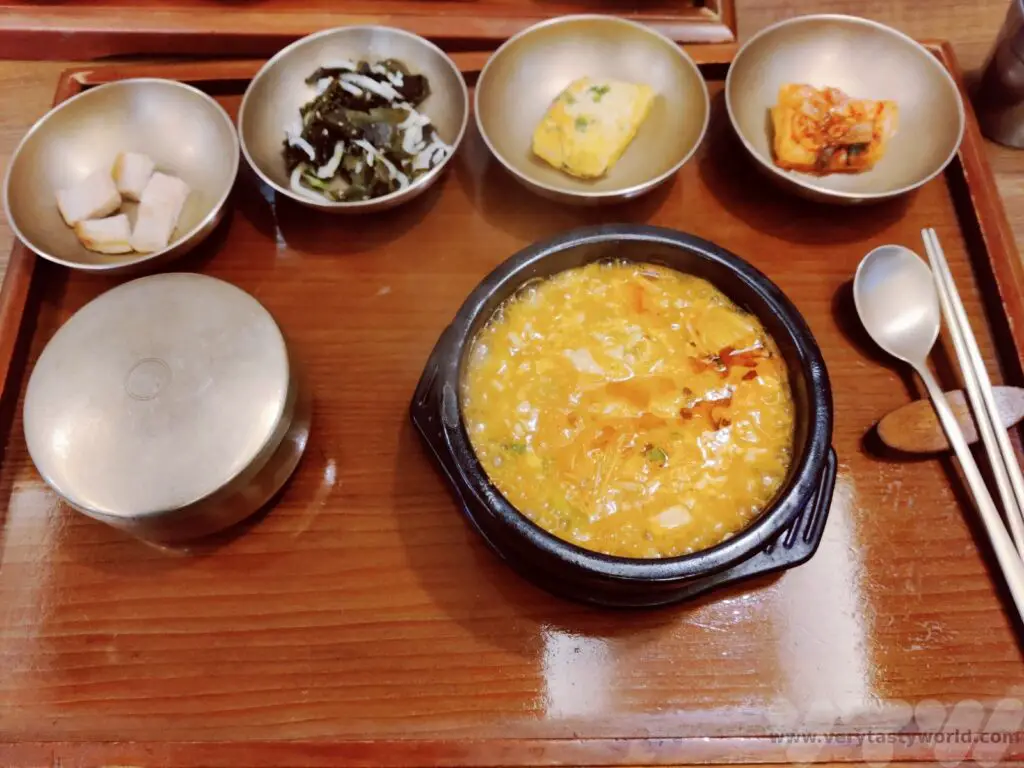
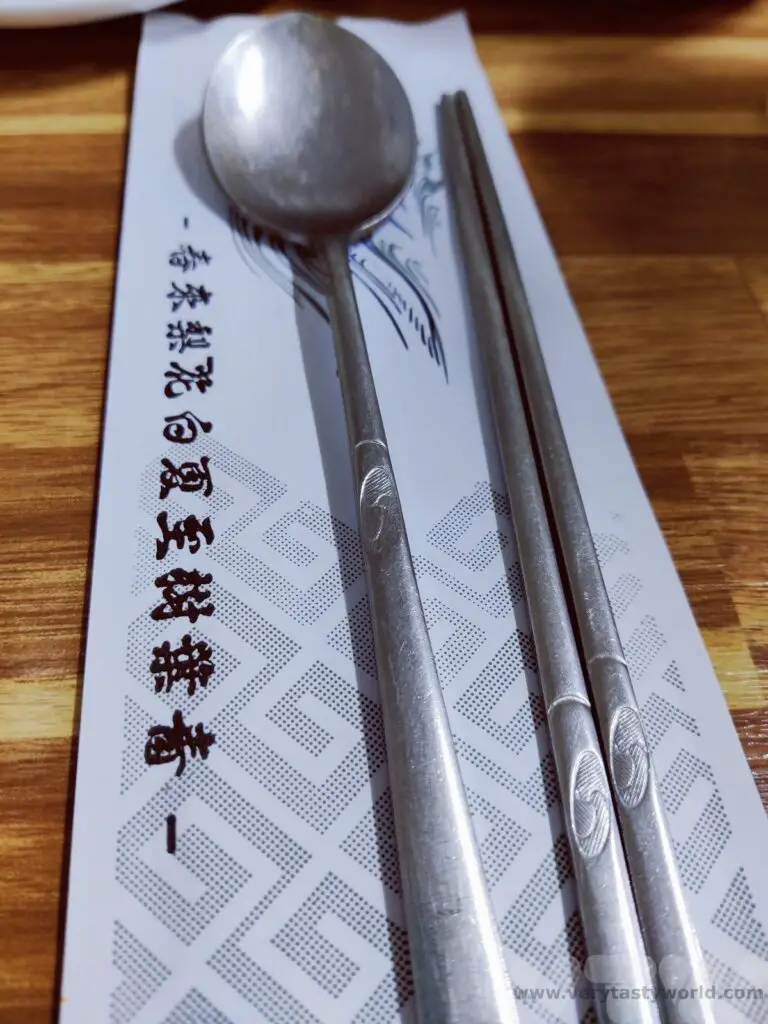
Koreans use chopsticks and a spoon to eat their food. Chopsticks are used to pick up specific items and the spoons used to scoop rice or eat soup.
Chopsticks in other Asian countries are usually made from wood but in Korea chopsticks are metal.
It is polite to use a spoon to drink soup – in fact, unlike many countries in Asia where it is okay to bring the rice or soup bowl to your lips, it is best to keep all bowls on the table. Use the spoon to bring rice or soup to your mouth.
There’s no formal way to eat rice. If served a stew with rice how you eat it depends on personal preference. Some people tip the rice directly into the stew, others scoop a spoonful of rice at a time and dunk it into the stew to pick up some of the flavour. And yet others never mix their rice with sauce and eat it plain.
Using a spoon and chopsticks is an efficient way to eat. In fact, over the course of our trip, we learned to use the spoon with our left hand and hold the chopsticks with our right – maximising eating potential! It’s absolutely fine to swap hands, put down the chopsticks down on the chopstick rest or on top of the bowl and pick up the spoon with the same hand. It’s considered that, as most people are right handed, another reason the soup is set to the right is so that it’s easier to use your right hand with the spoon to avoid spillage.
Don’t stick your chopsticks vertically into your food as that is the way that offerings are made to the deceased at funerals.
If you are eating with a group, the eldest members of the party will eat first.
When it comes to drinks it’s polite to order just a suitable number of bottles of beer, soju (a clear distilled spirit which normally has the strength of fortified wine) or makgeolli (a cloudy rice wine which has a similar ABV to beer) and share rather than order one for each person. You can always order another. You shouldn’t pour your own drink but pour for others using both hands. The recipient should hold the cup or bowl with both hands to receive.
Before starting to eat, say, ‘jalmeokgesseumnida’ which means ‘eat well’. If you get it wrong you won’t be ostracised but the correct etiquette will be appreciated.
One of the most delightful things we found about dining in restaurants was how keen the local people were to show us how to eat the food. For example, if you order bibimbap – mixed delicious things served over rice – you receive a bowl of beauty then dig in with the spoon and mix it all together before scoffing. Even if we couldn’t speak much Korean, the restaurant staff would demonstrate what we should do with each dish. It was very helpful.
Restaurant Dining
Many restaurants offer a self-ordering process where you walk up to a machine and place the order. Pretty much every restaurant we visited that had self-ordering had an English language option, as well as Japanese and Chinese. We found that most restaurants had an English menu which was sometimes quite basic but absolutely fine. Where restaurants didn’t have an English menu, we either guessed (we had learned to read Hangul before travelling so could tell what we were probably eating but didn’t know how it was cooked, but that’s okay as we eat pretty much anything) or we pointed to pictures of the food.
If you have ordered using a machine, order the food and either wait for it to arrive or for the number on your ticket to be called out. Keep an eye out at the serving hatch if you don’t know your number – the staff will most likely know that the food is for you and will beckon you over.
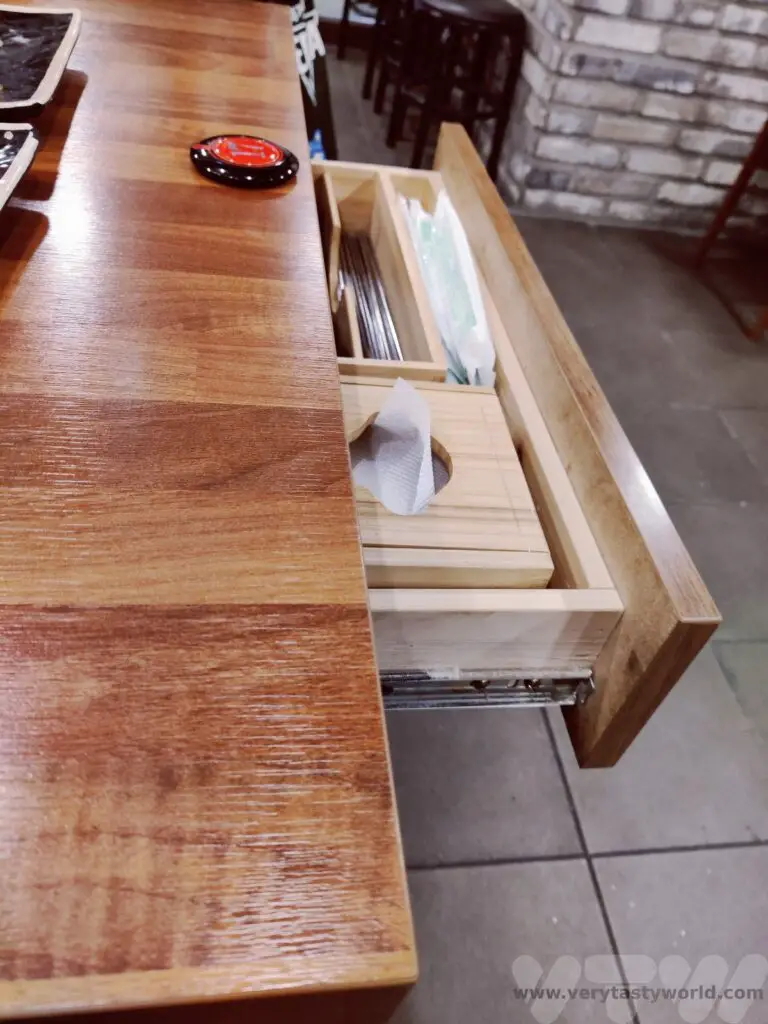
If you can’t find chopsticks and spoons on the table, they will almost certainly be available – either in a box or, rather cleverly, in a drawer under the table. The Golden Rule for a Korean restaurant: always look under the table.
Also, if you want to call over the waiting staff, there is often a button on the table which you can press.
Water is always provided and it’s free of charge. Many restaurants will bring you a bottle or jug of water and some cups but you may have to help yourself. If this is the case there will be a water dispenser and cups available somewhere in the restaurant.
Korean meals always come with banchan – side dishes. Sometimes these will be brought to the table and other times there will be a self-service bar where you can pick up a dish and fill it yourself. Look out for broths as well – there is often soup or broth in a large vat somewhere in the restaurant. It will be a rare meal when you aren’t supplied with kimchi, the ubiquitous and delicious spicy fermented cabbage, which is Korea’s national dish.
At some restaurants the bill was placed on our table when the food was delivered, at others we paid in advance using the machine and yet others the bill was calculated afterwards. You don’t request the bill – just saunter up to the payment area and pay. Cash is fine, cards were accepted in most places. Tipping is not expected nor required. Indeed, like Japan, tipping can sometimes be considered rude.
The Joy of Banchan
One of the most amazing things about Korean dining is banchan – the side dishes. The variety of banchan is quite remarkable. And they aren’t just thrown together. As much care is taken in preparing the banchan as the main dish.
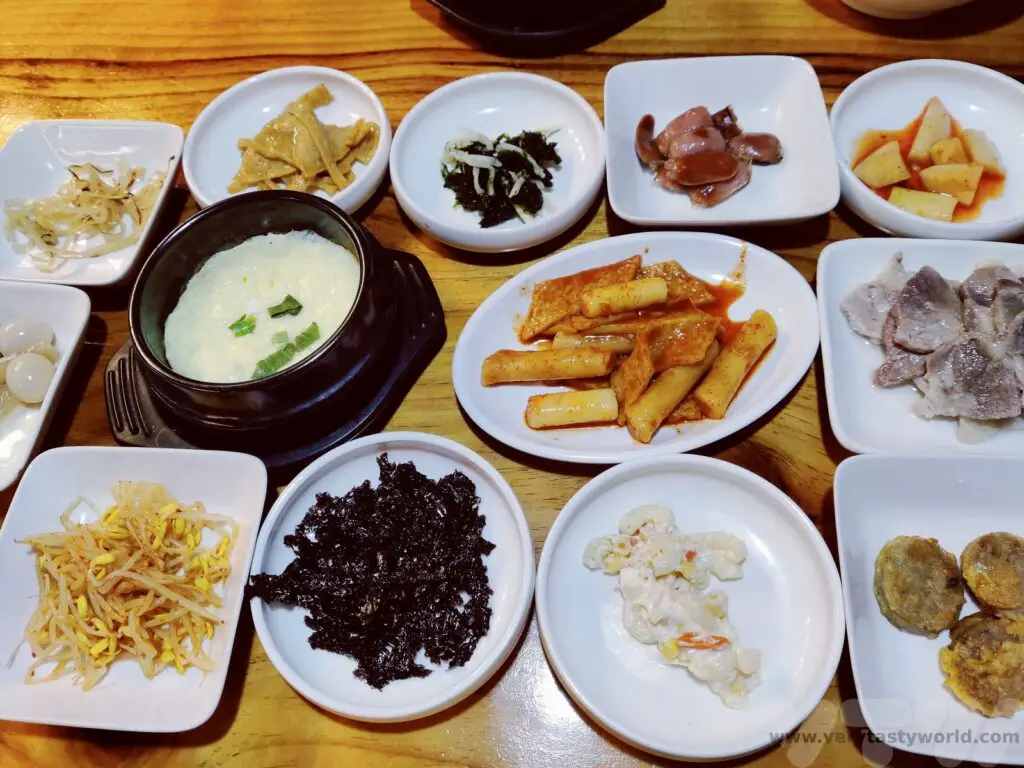
And the very best thing about banchan is that you can order more for free! (It would be a bit rude to ask for more of the dish you have ordered or extra rice, unless you are happy to pay more.)
Of all the banchan, kimchi is the most famous. This crunchy, spicy fermented cabbage dish will be eaten with almost every meal. Even our airline meal to Korea included a packet of kimchi.
It is such a fundamental part of society that it has its own day – 22nd November – and families get together every year to make kimchi. Kimjang: Making and Sharing Kimchi was inscribed on the UNESCO Representative List of the Intangible Cultural Heritage of Humanity.
Korean households usually have two refrigerators – one for normal food and the other, which is set at a specific temperature, for a year’s worth of kimchi! We have been making kimchi for years and have an easy kimchi recipe.
Quintessential Korean Dishes to Try
Bibimbap
This is one of the most well-known of Korean dishes. It is a rice bowl topped with all sorts of delicious ingredients – from vegetables to marinated meat – sometimes garnished with a fried egg. Gochujang, the spicy (not overly spicy) chilli sauce forms the basis for the flavour. Sometimes the bibimbap is presented with the toppings on the rice but in ‘fast food’ bibimbap restaurants the toppings will be placed in the bowl and you will be served the rice separately, to put on top yourself.
The best way to eat bibimbap is to admire it first then get your spoon in and mix it all together, add some sauce, mix some more and then scoff.
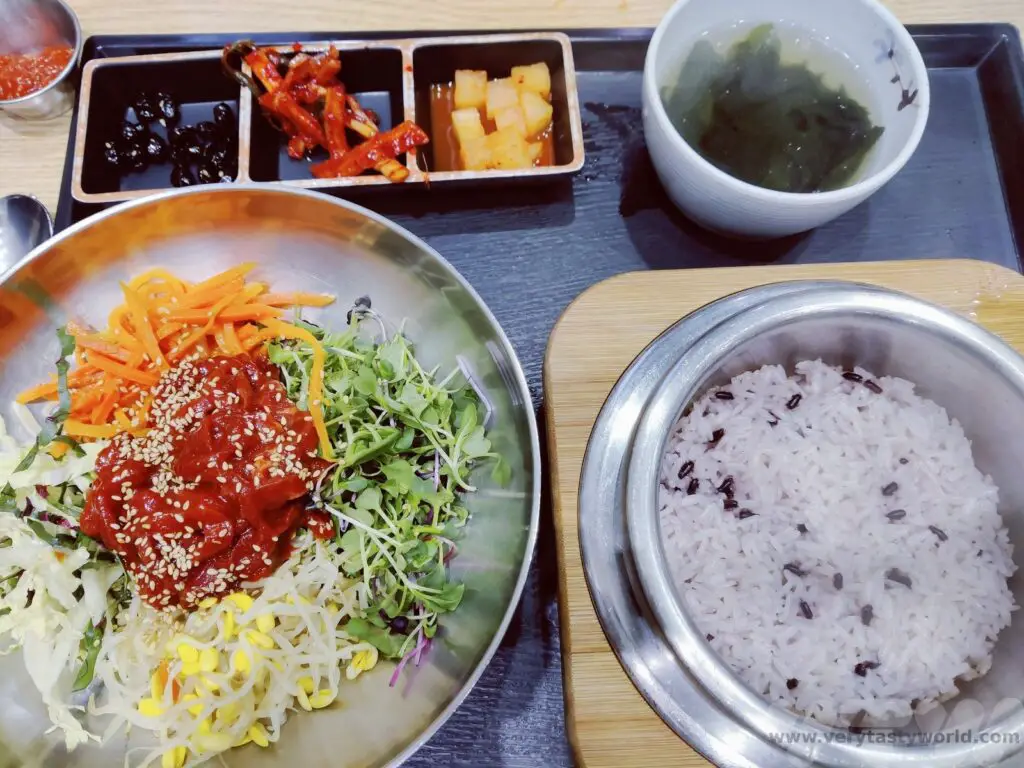
Sharp-eyed readers will notice that in the picture above the rice is served to the right. This is because we were given a tea pot and , after transferring the rice into the bowl of goodies, we then added hot stock to the rice crust inside the bowl to make a lovely soup.
Gimbap
They may look like Japanese sushi maki (sushi rolls) but gimbap (gim = seaweed, bap = rice) are very different. They are not seasoned with vinegar but sesame and they are sauced internally. Whereas maki often largely comprise raw fish, gimbap includes a vast array of ingredients – there is much more filling than rice. You can expect pickles, fresh vegetable, meats/fish or omelette all lovingly wrapped in a seaweed casing. You don’t dip them in soy sauce or wasabi. Many gimbap outlets in the cities are open 24 hours so this makes a great breakfast option.
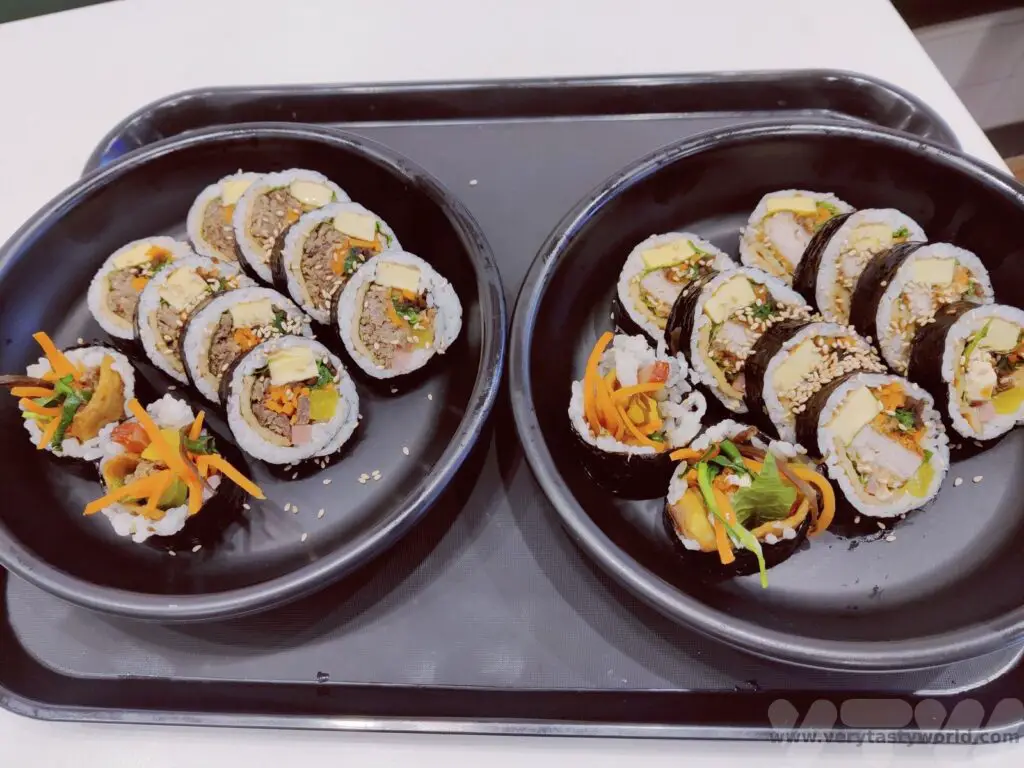
BBQ
Another essential meal to enjoy while visiting Korea is BBQ – luscious cuts of meat, sizzling on a hot plate, cooking over fire (sometimes butane but charcoal is traditional which adds a delightful smoky element).
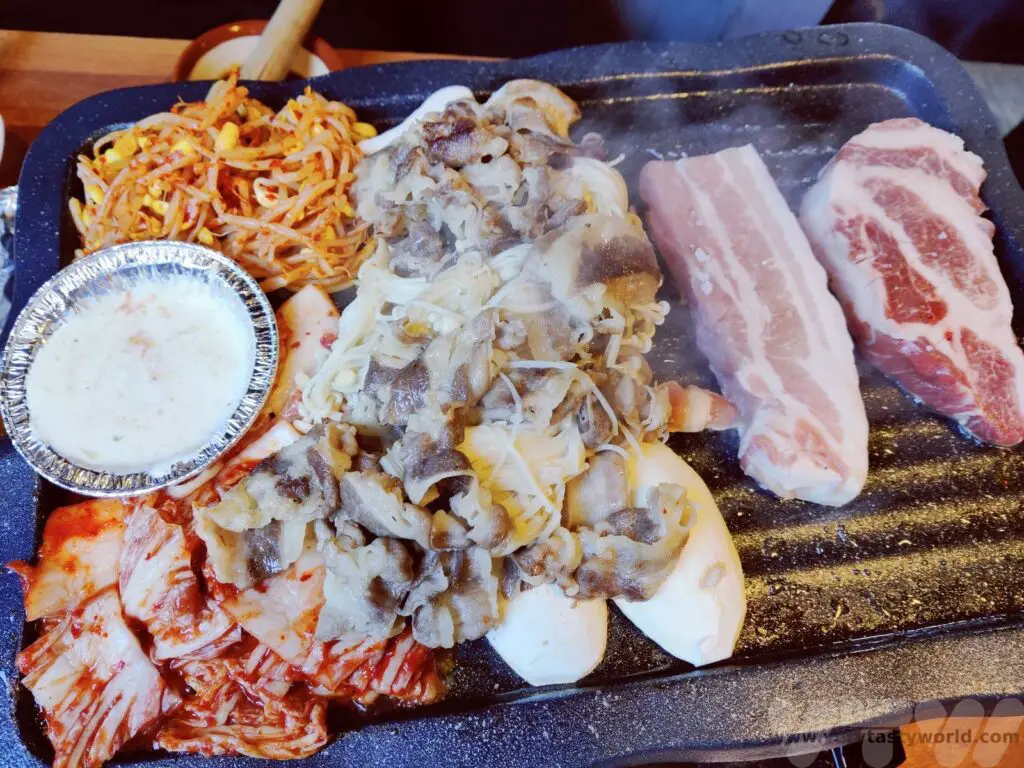
And BBQ is where another brilliant Korean table setting element comes into its own: the scissors! Korean kitchen scissors are the absolute best, they have thicker blades than ordinary scissors and cut food quickly and efficiently.
The meat is initially seared and cooked as a full joint. Then, as it cooks, tongs and scissors are used to cut the meat into bite-sized strips.
If you aren’t confident doing the cooking, the staff are absolute experts and will know exactly what to cook and in what order, so you can sit back, sip a soju and enjoy the show. But if you fancy having a go it’s fine to go for a DIY approach.
Ssam, which means ‘wrapped’, is a great way of enjoying BBQ. As well as banchan, a number of different leafy vegetables will be supplied – lettuce leaves or herbs such as perilla (below). You pick up a juicy piece of bbq meat with your chopsticks, place it on the leaf, add some kimchi and a dab of sauce, then wrap it up and pop it into your mouth – delish! If you run out of leaves, you can always ask for more.
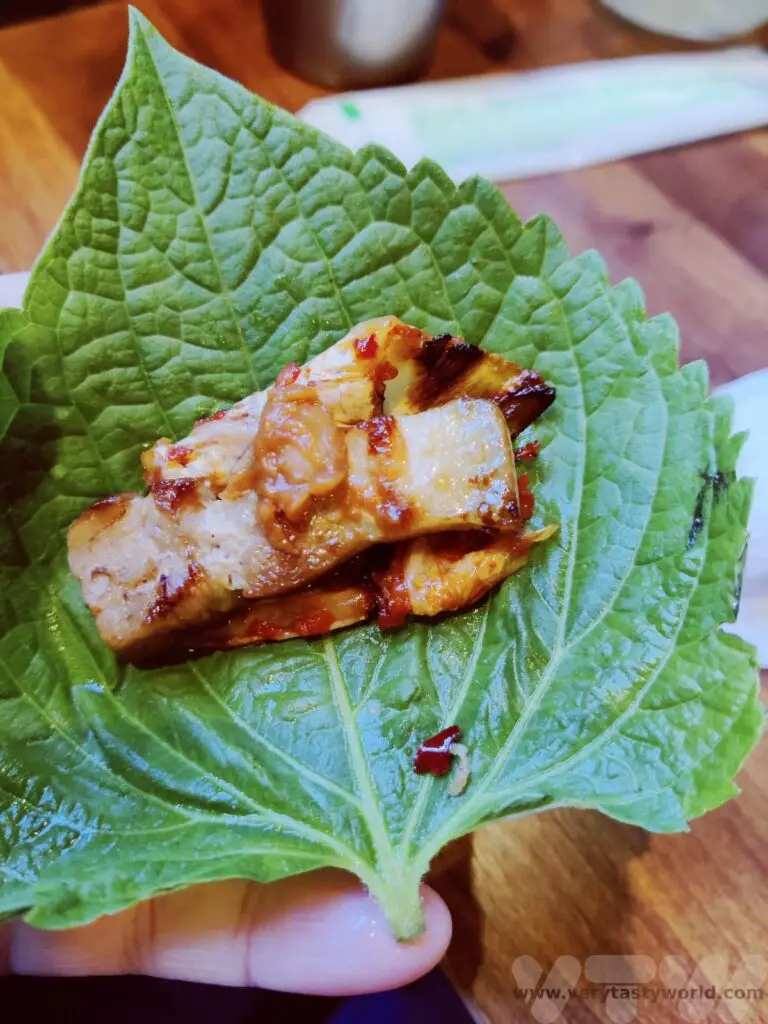
Chimaek (Chicken and Beer)
KFC is an essential item to try when visiting Korea. Not that KFC, of course, but Korean fried chicken. Chimaek 치맥 derives from chikin = fried chicken (unsurprisingly) and maekju = beer.
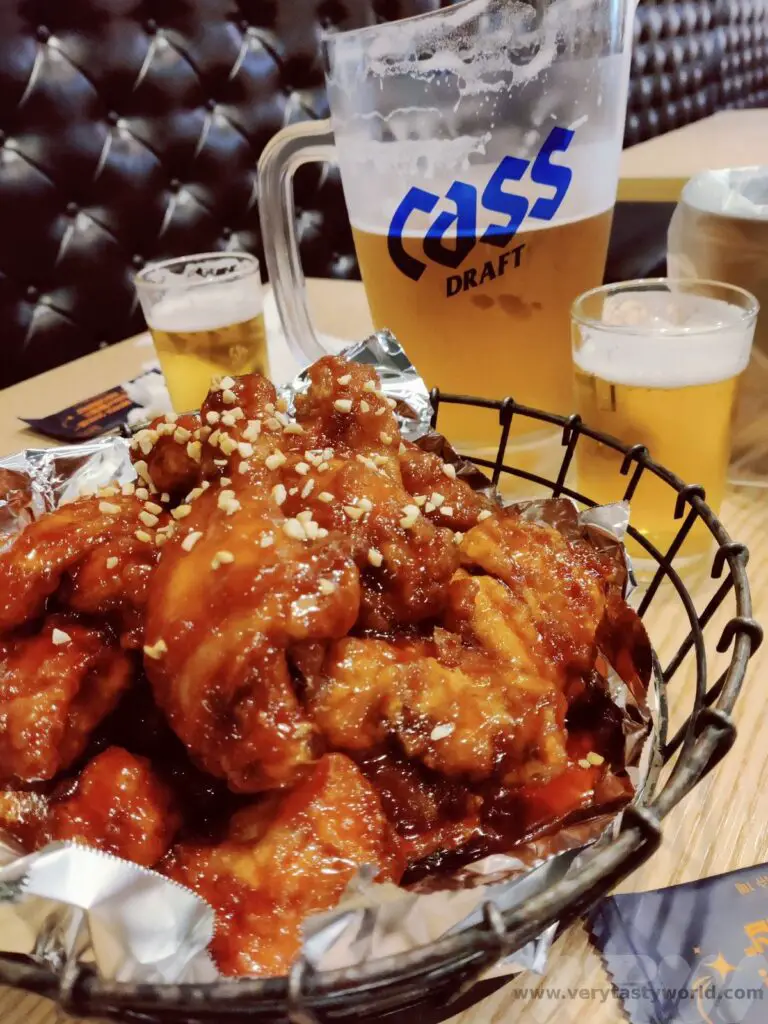
A very sociable way to enjoy fried chicken is to scoff it with beer and enjoy it with friends. When we visited a chicken and beer restaurant in Busan a single order provided a whole chicken’s worth of deep-fried joy, in a spicy sauce. Local beers are much cheaper than imported.
Bulgolgi
Bulgolgi is very popular dish comprised of marinated thinly slices of meat, usually beef, cooked on a griddle. The name translates as fire meat (bul = fire, golgi = meat). Some restaurants will offer a set menu where bulgolgi forms the centrepiece of the dish and you have multiple banchan to accompany, other restaurants let you cook the meat at the table. Just use your chopsticks to pick heavily flavoured, succulent pieces of meat.
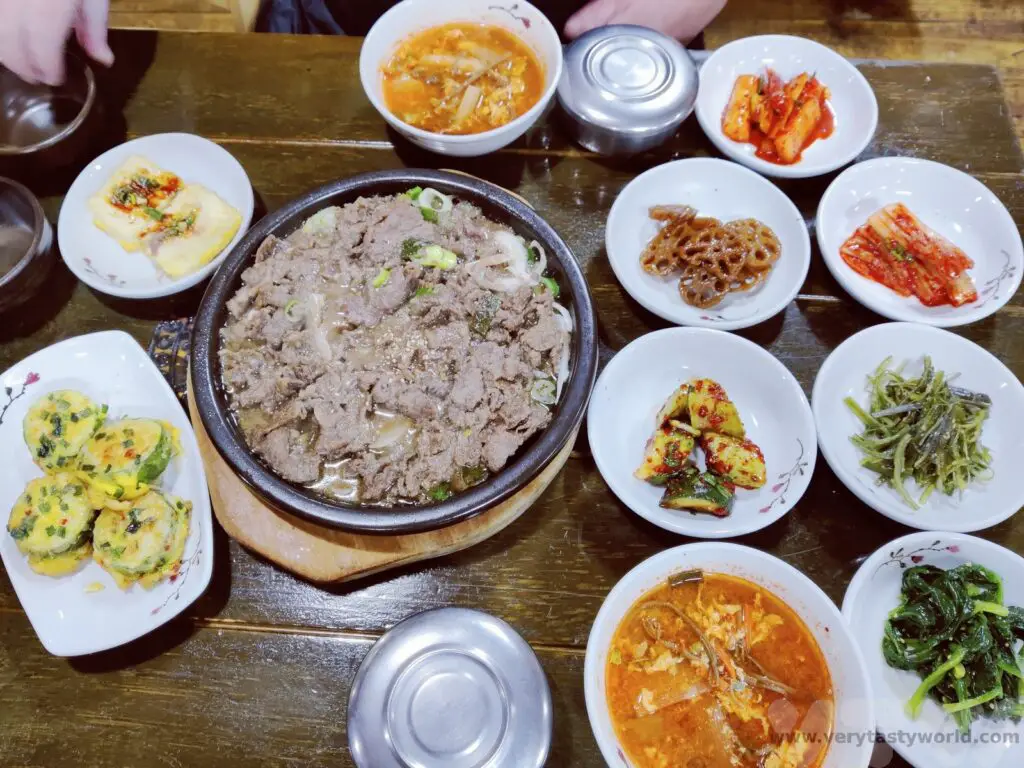
Jjigae (Korean stew)
We visited in November and temperatures were dropping fast as winter approached. Jjigae is comfort food – warming and delicious. There are many varieties available – meat, tofu and vegetables – seasoned with a variety of sauces. Gochujang (chilli paste) and doenjang (soy bean paste, a bit like miso) are popular options. Stews will always be accompanied by rice and banchan. It makes for a feast.

Pajeon (Korean pancakes)
Pajeon is a celebratory food. These are pancakes that incorporate vegetables (largely spring or green onions) and other delectable fillings such as seafood.
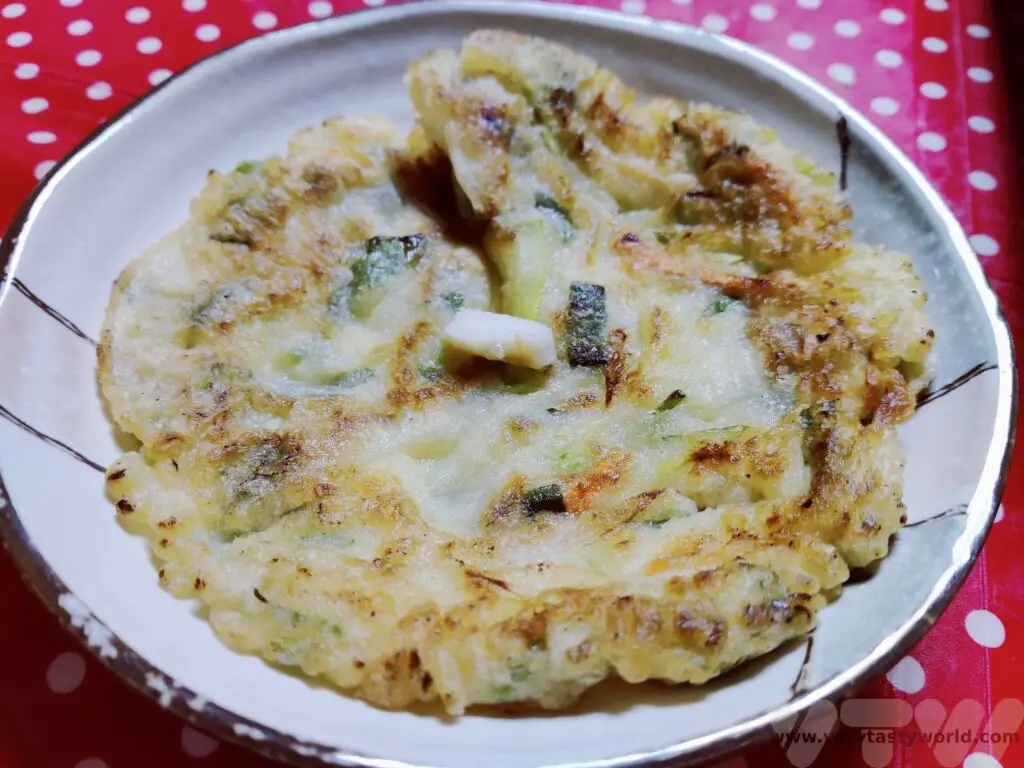
Eomuk – Fishcakes
Minced fish with vegetables and seasonings is another popular dish. These are available in shops/restaurants but are also widely available as street food.
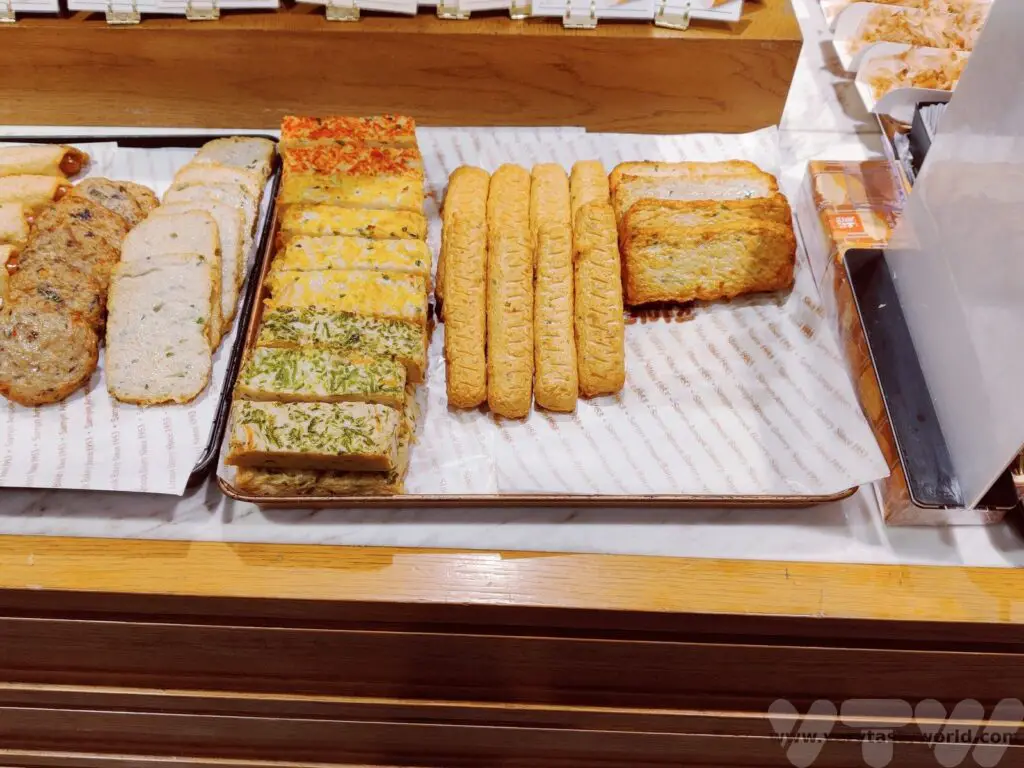
Dining At The Market
Both Seoul and Busan have large and extensive fish markets and it is possible not only to visit them but you can also eat incredibly fresh fish in the restaurants on the upper floors.
If you want, you can buy the fish in the market and then take it upstairs to be cooked to your liking. There will be a table charge (which may be reduced if you decide to order the restaurant’s fish stew) and a cooking charge.
In Busan, the Jalgachi market is the largest in South Korea and has multiple restaurants on the first floor, which all have the same menu. In Seoul some of the restaurants in the Noryangjin fish markets will help you – either by explaining the process, or by offering a picture menu where you can choose your fish/shellfish (they will give the market price) and they will go downstairs to buy the fish for you.
We enjoyed a plate of raw wild fish, sashimi style with eye-wateringly fiery wasabi. It was very different to the Japanese sashimi we have eaten in the past. It didn’t melt in the mouth but had a much firmer texture. The sashimi was accompanied by wonderfully sweet pan-fried rockfish, fresh crab and deliciously umami fish stews.
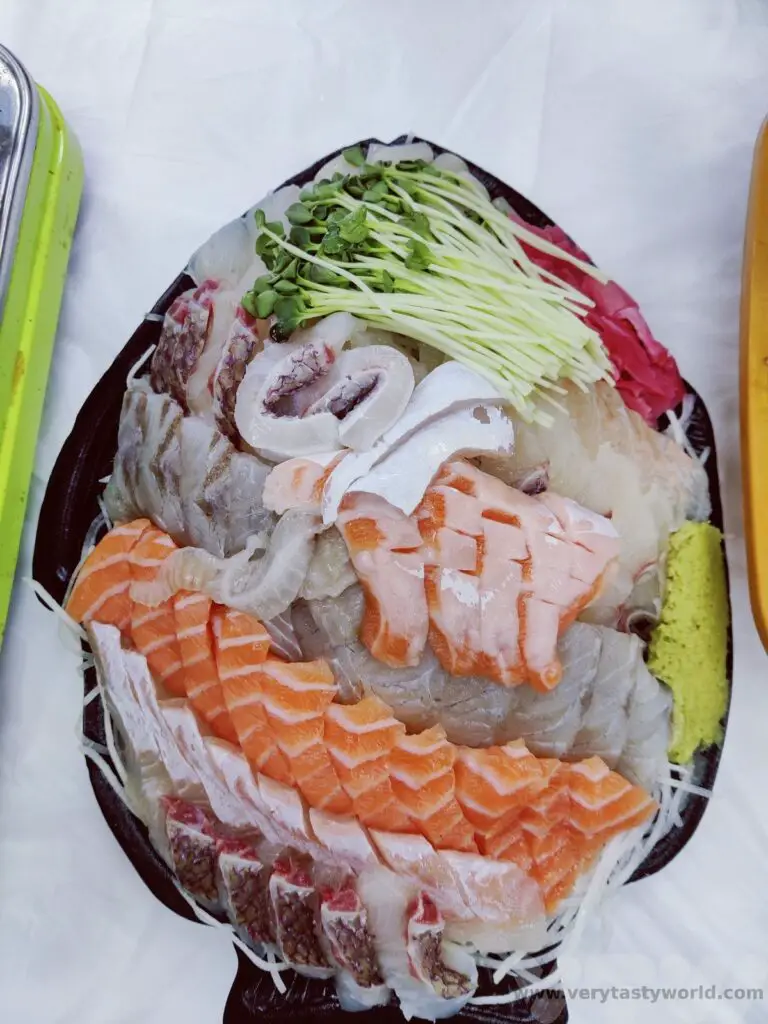
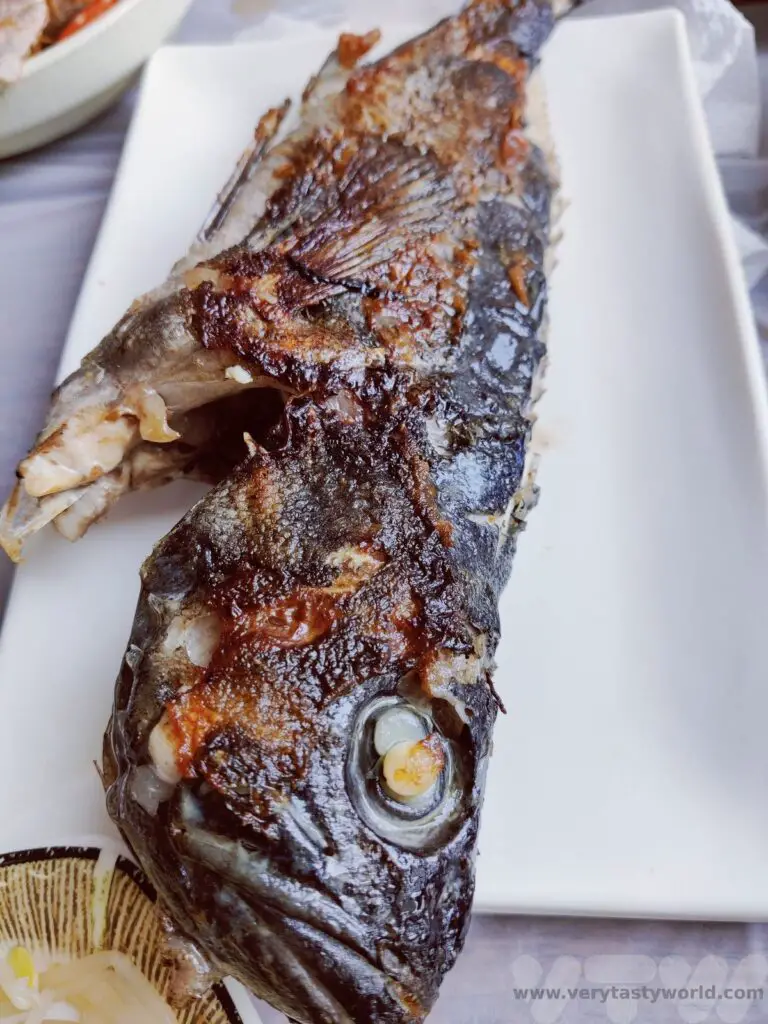
If you’re eating crab those amazing Korean scissors come into play – they will easily cut through the hard shell then you can use a chopstick to pick out the sweet and succulent crabmeat.
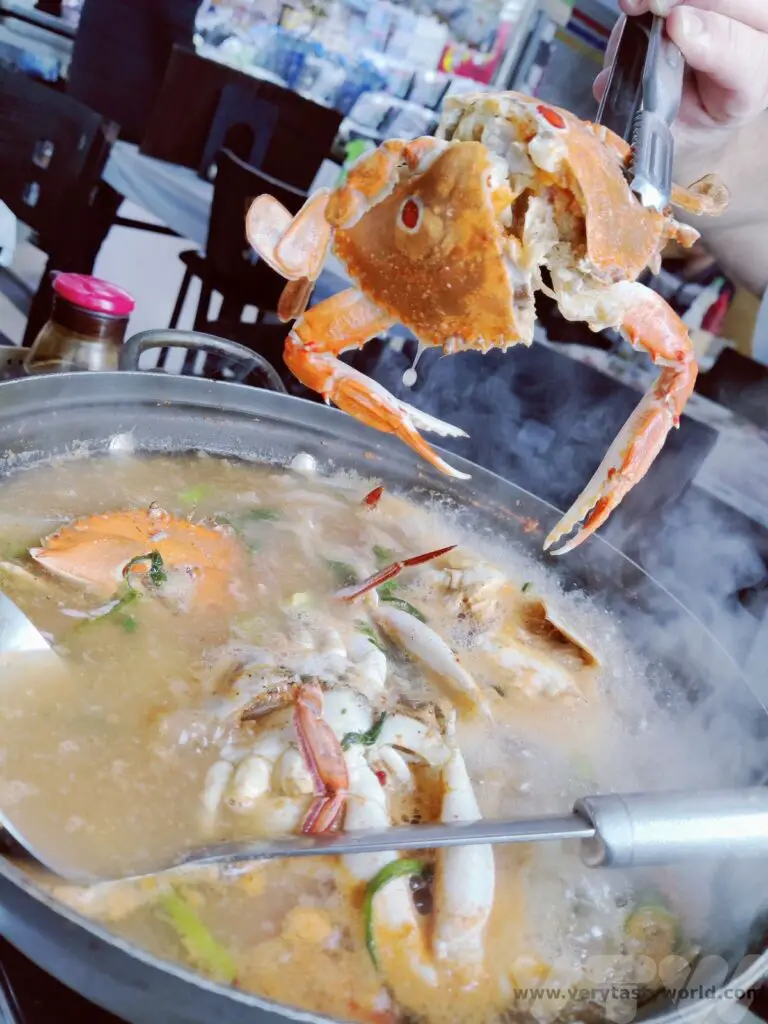
Street Food
The very first Korean food we tried was at a local market which we had decided to explore just as we had arrived in the afternoon in Seoul. Feeling tired and slightly woozy after a 16 hour journey, we sauntered up to a market stall and bought a fishcake for a mere 1000 won (less than $1). This undulating slice of fishy goodness woven along a wooden stick and served in a cup with a generous splash of stock was sublime – warming and packed with umami. We were instantly sold on street food.
We decided to have breakfast at Seomun market in Daegu one day. There was a wide variety of food on offer. Some of the fishcakes keep warm in a broth – watch out for the red-tipped sticks as those will be the spicy ones!
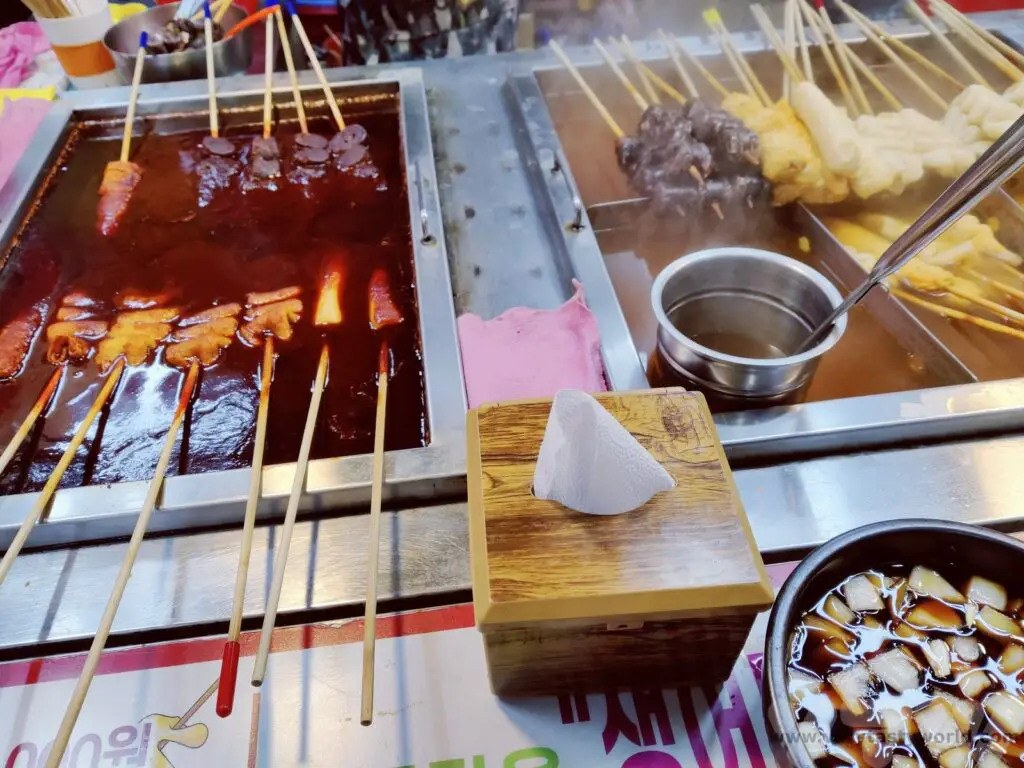
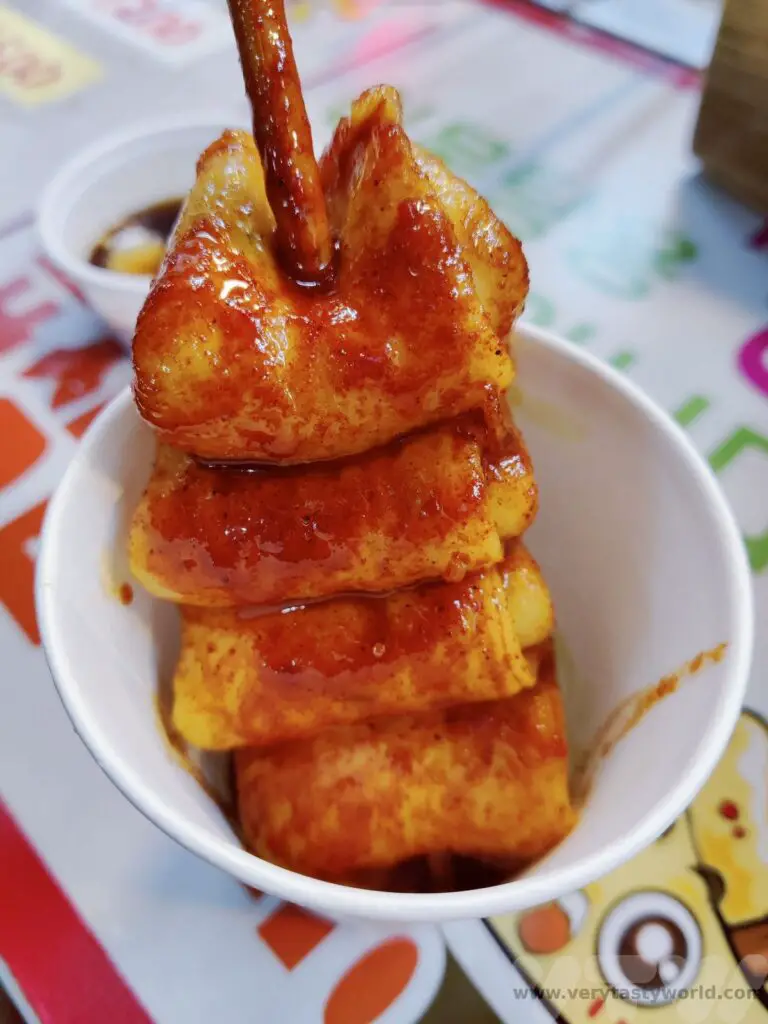
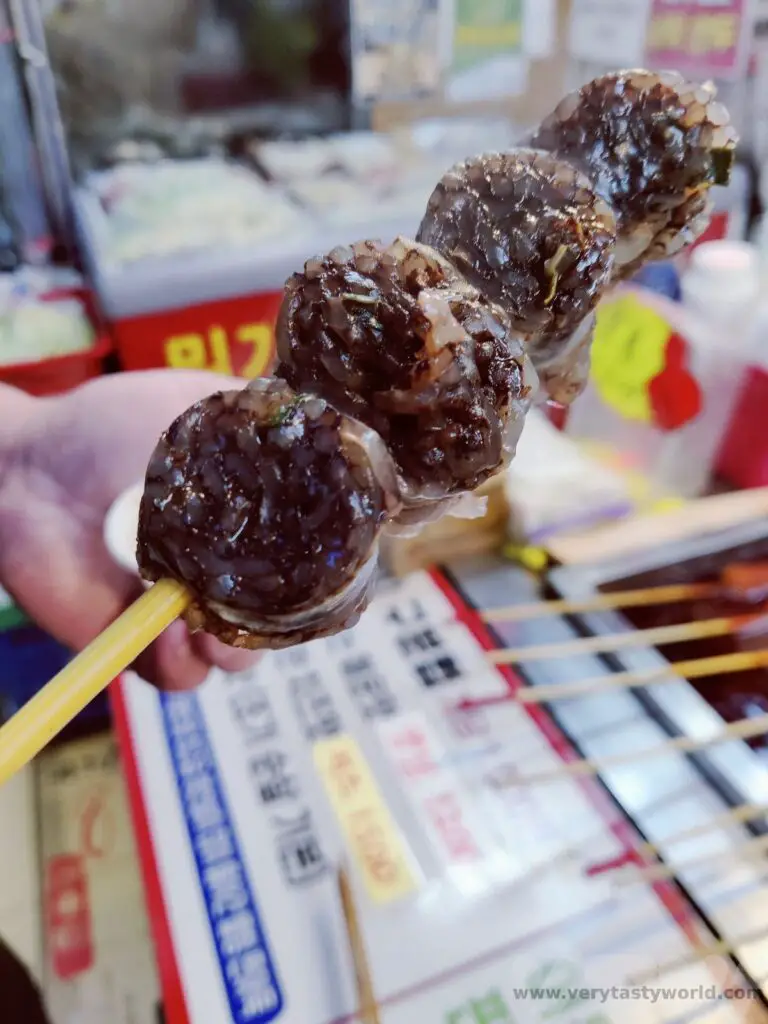
Hotteok (sounds a bit like hot-dog) is a fluffy fried doughnut filled with seeds and nuts.
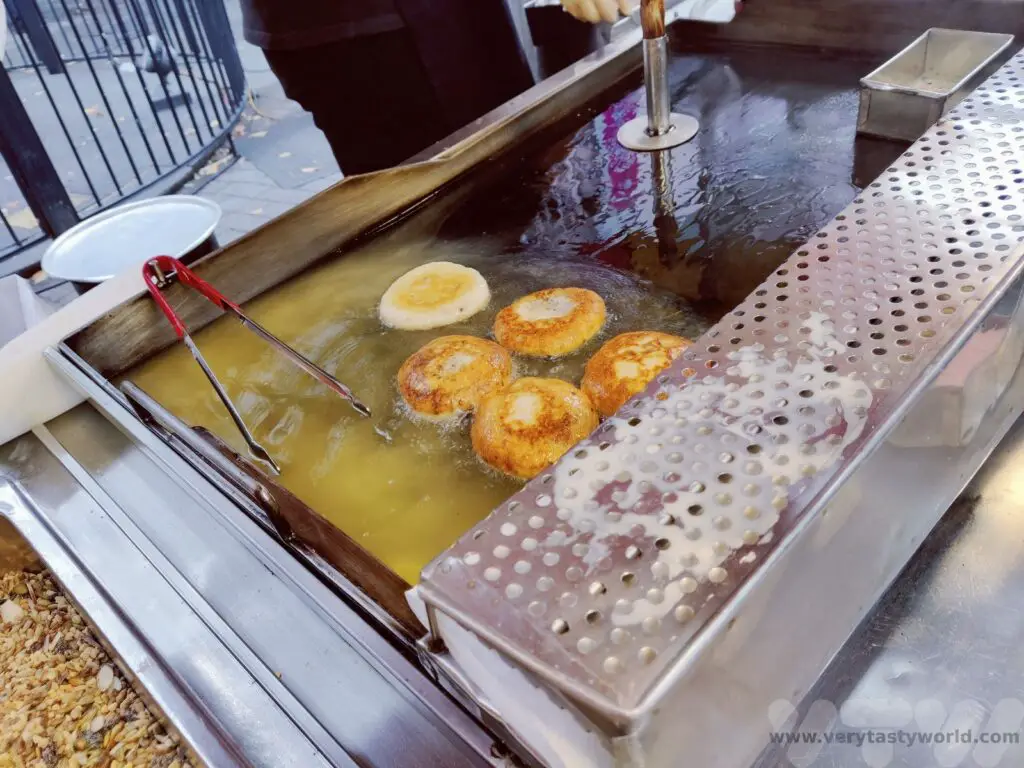
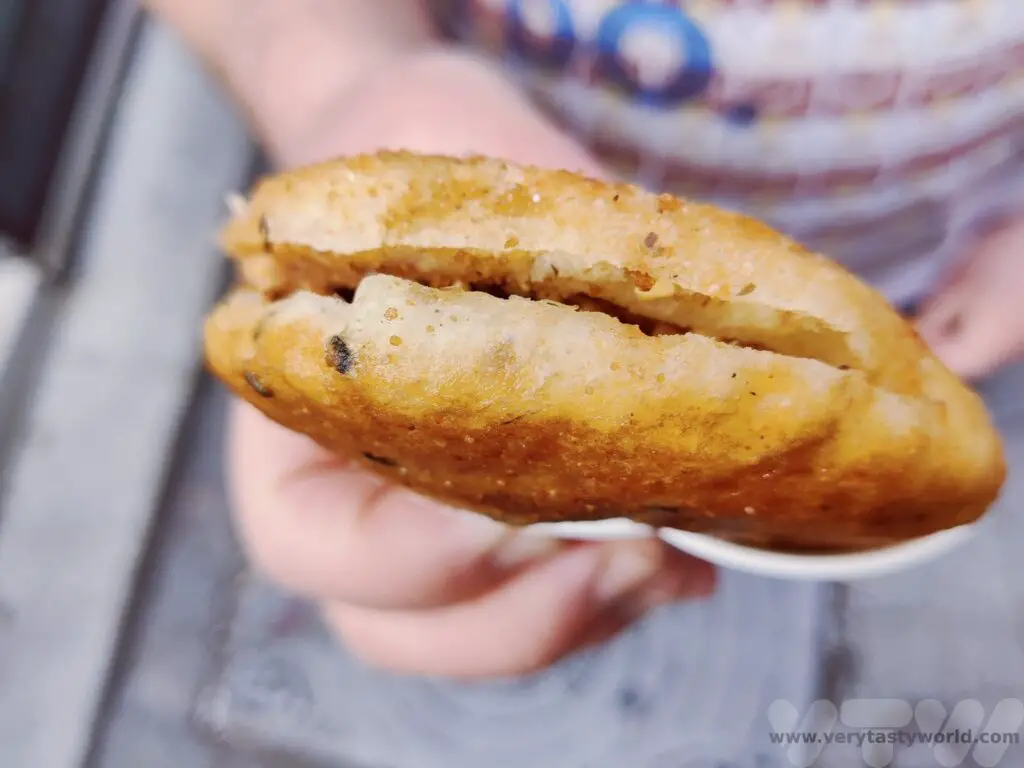
Many market stalls make pancakes fresh to order.
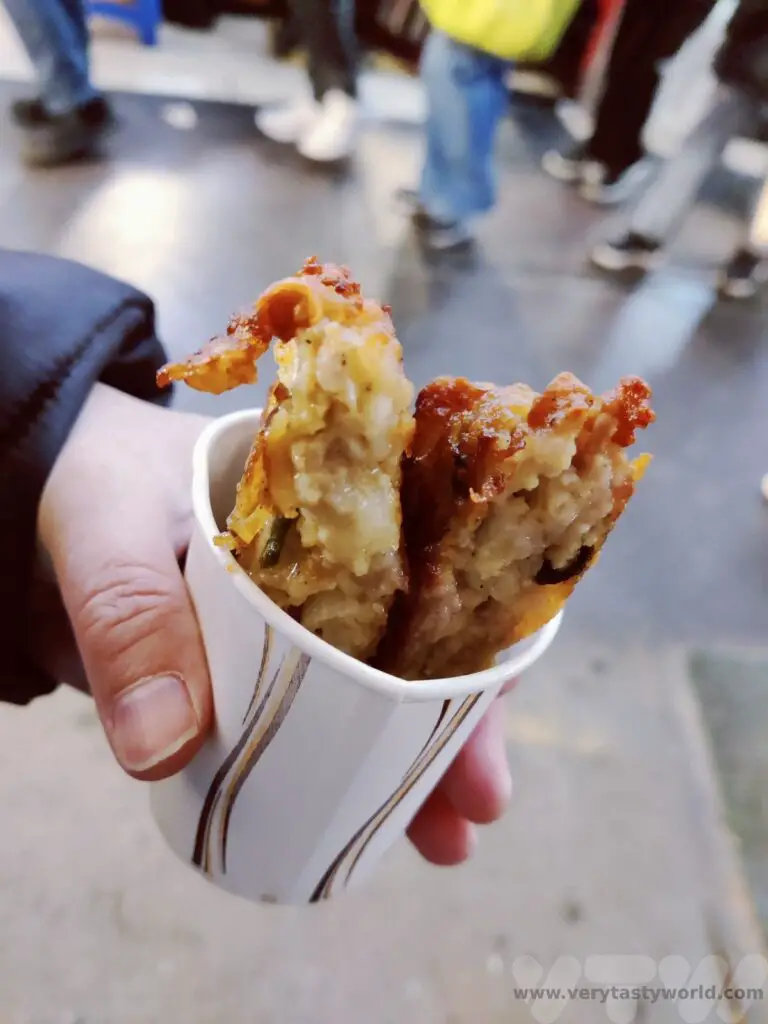
Most street food is served in paper cups.
Vegetarians/Vegans
It is not impossible to dine well if you are vegetarian or vegan. We did spot some vegan restaurants in many of the cities we visited. Veggie options will be available – e.g. tofu stews – but you might have to be careful that the base stock is vegetable based as some of these may use fish.
A menu that did make us laugh a little was a dumpling restaurant in Gyeongju. The proprietor was absolutely delightful and made awesome dumplings, plump and filling, in a variety of styles. But the menu was admirably honest about the fact that there was pork in all the savoury dumplings. Which is actually reassuring.
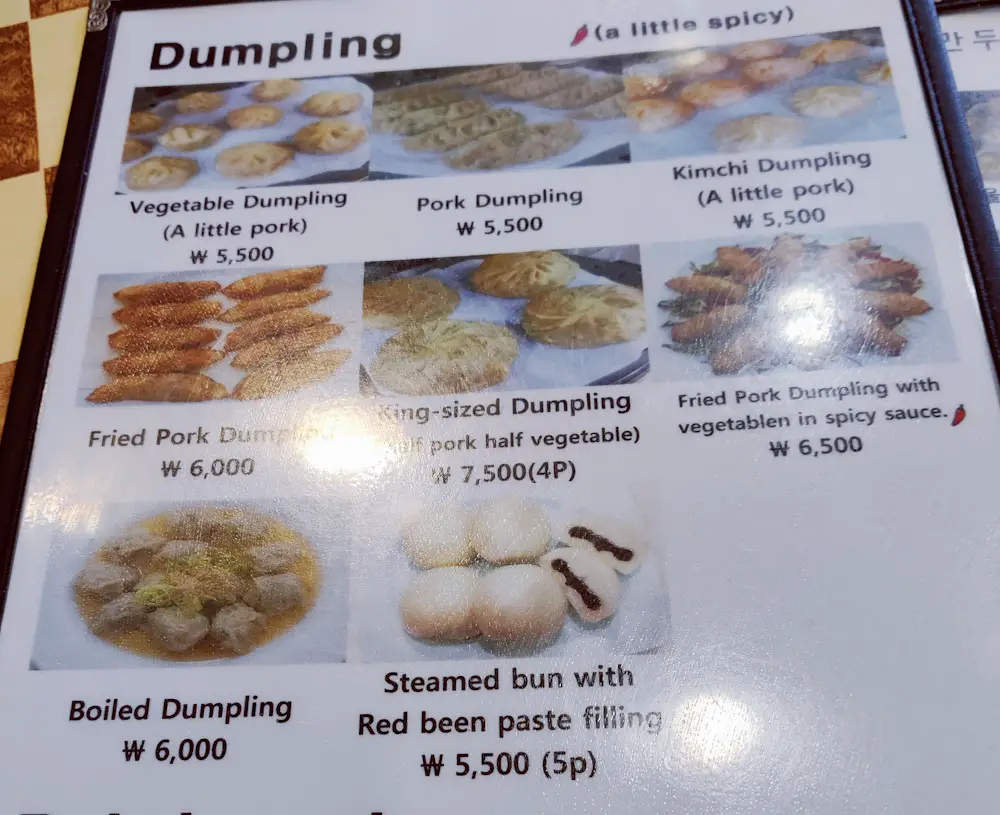
Some Useful Phrases
| Please give me | 주세요 | joo-say-yo | Say at the end of the sentence after the thing you want. e.g. banchan joo-say-yo |
| Excuse me YOU – over here | – 저기요 | juh-gee-oh | To get attention |
| People | 세명 | doo myung | 2 people. If you want a table for 2, it’s fine to just indicate with your fingers |
| Bottle | 맥주 여섯 병 | maek-ju doo byung | maek-ju (beer) doo byung (2 bottles) |
| 1 more bottle of soju please | 소주 두병 더 주세요 | so-ju hana-byung duh joo-say-yo | |
| More | 더 | Duh | |
| Please give me more kimchi | 김치 더 주세요 | kimchi duh joo-say-yo | |
| This please (pointing) | 이거 주세요 | Ee-guh joo-say-yo | |
| Delicious | 맛있어요 | mah-shis-say-yo | Saying this was guaranteed to raise a smile at the end of our meals! |
| NUMBER | KOREAN | Korean pronunciation |
| One | 하나 | hana |
| Two | 둘 | dool |
| Three | 셋 | sayt |
| Four | 더섯 | nayt |
| Five | 더섯 | duh-suht |
| Six | 여섯 | yuh-suht |
| Seven | 일곱 | ill-gope |
| Eight | 여덜 | yuh-duhl |
| Nine | 아홉 | ah-hope |
| Ten | 열 | yuhl |
| Eleven | 열하나 | yuhl-hana |
A Cookery Class
A fun way to spend an afternoon in Seoul or Busan is to join a cookery class. With a small group of fellow travellers these classes usually involve a visit to a local market to learn about the amazing produce on sale – from the familiar to some enticingly unusual foods.
Then you’ll go on to visit your host’s home to cook several delicious dishes. We made pajeon – and had great fun flipping the pancakes. Bibimbap and dakgalgi (a spicy chicken dish) were also on the menu.
Related Posts You May Enjoy

Thanks so much for reading. We hope you enjoyed this article. If you’d like to keep up to date with new posts and recipes, please subscribe to our newsletter or follow us on social media – X, Facebook or Instagram. We always love hearing from you and would be delighted to read your thoughts about this article.

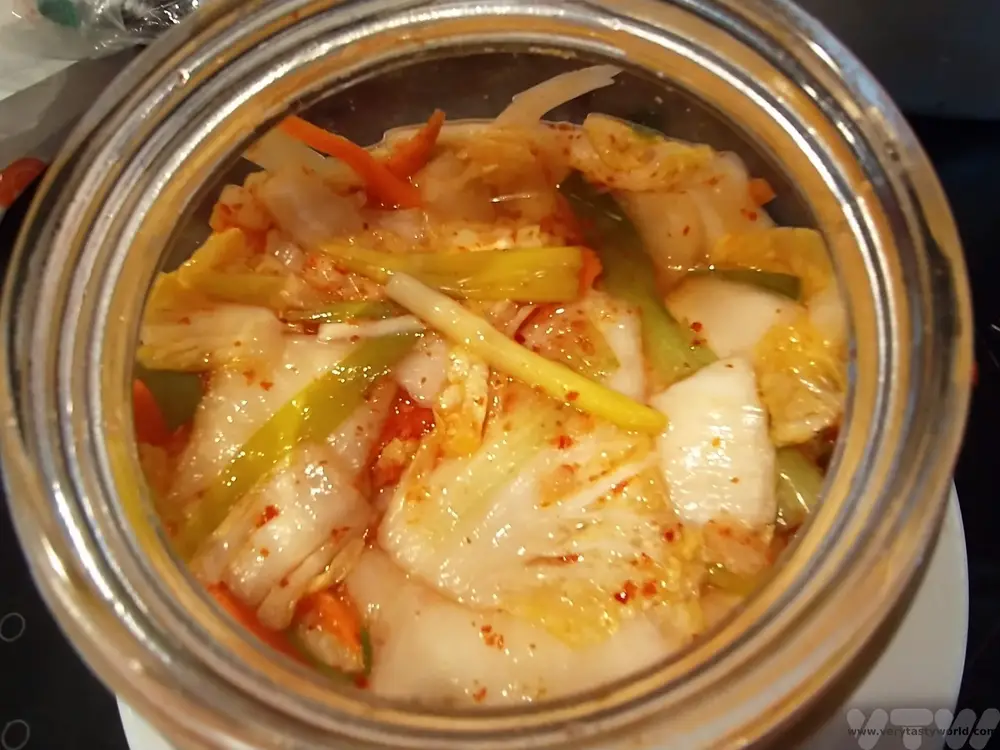
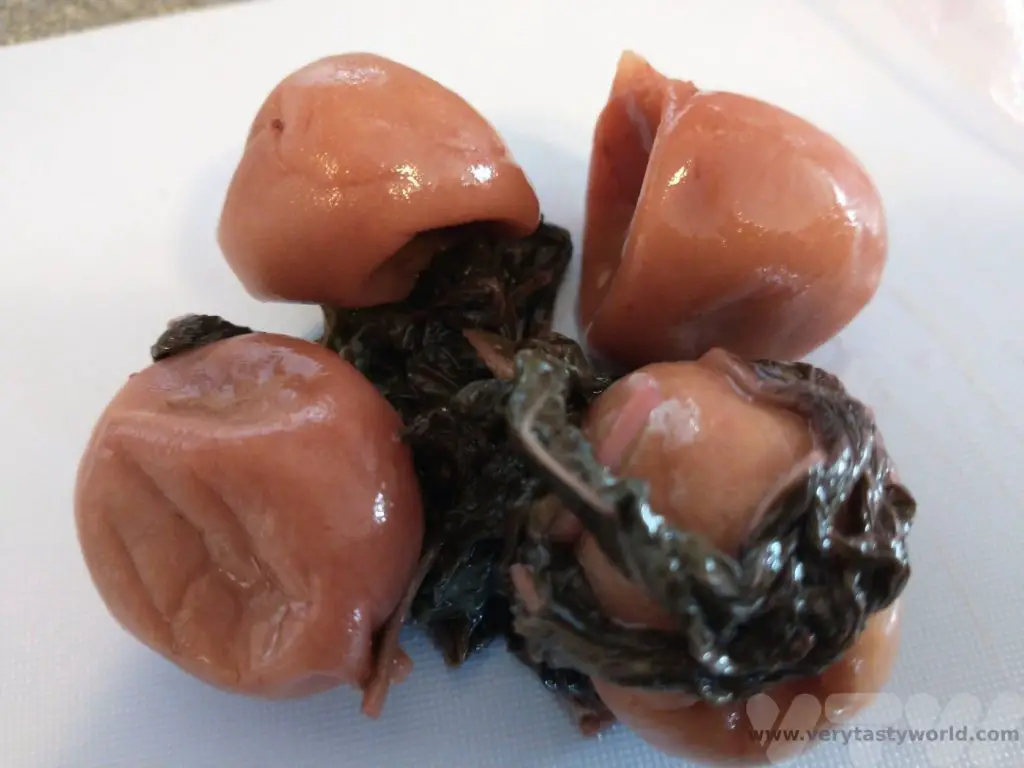
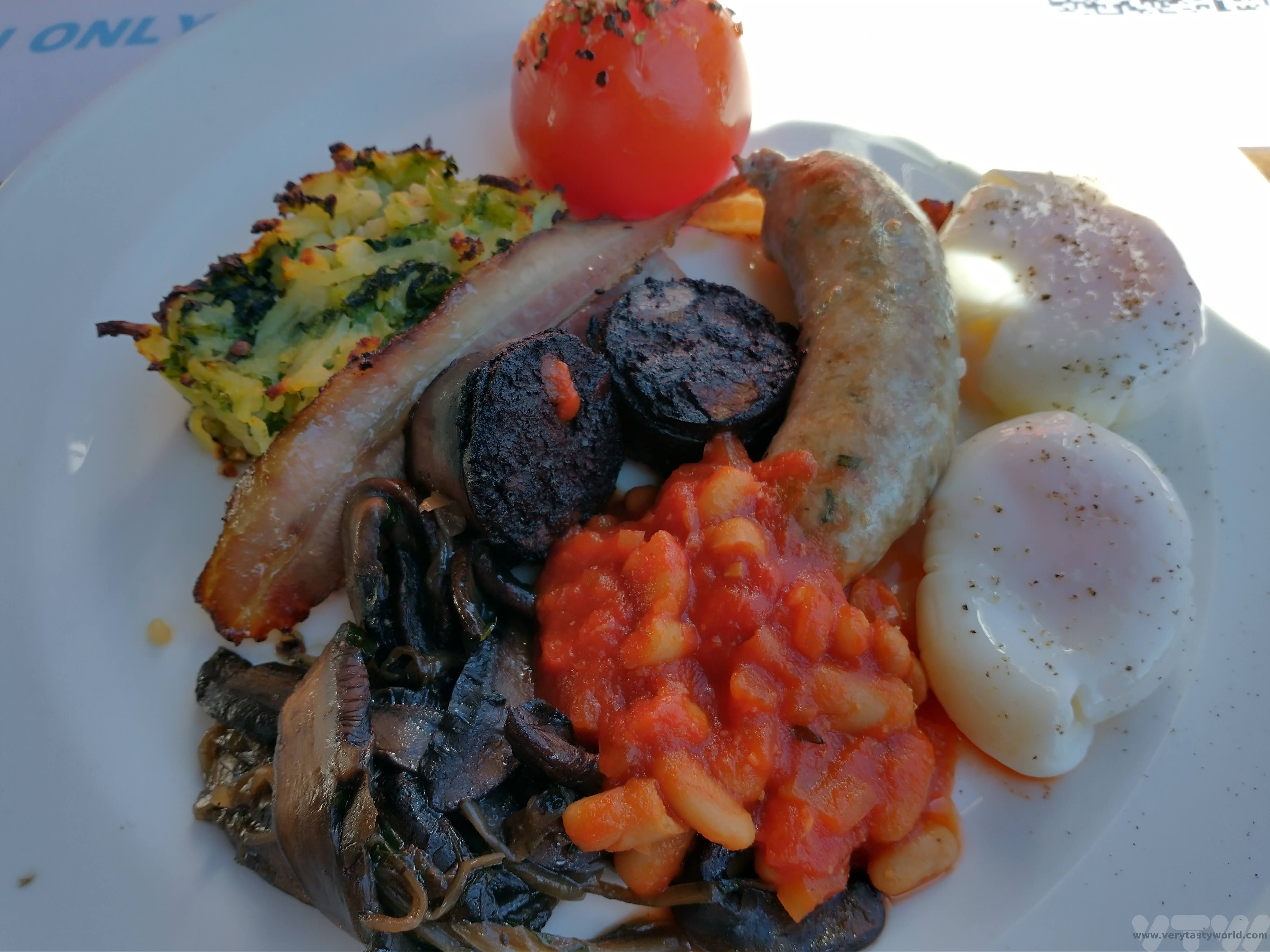








I always find it fascinating to understand the culture and table etiquette of other countries, especially those that diverge so much from Western culture.
Everything in this post looks delicious and worth trying and savoring 🙂 from the Banchan (I love snacking on appetizers), to the soul-comforting Jjigae, I think it would be a feast!
Excellent gastronomic guide, congratulations!
Thank you so much for your kind words. Like you, we find the culinary culture and etiquette to be fascinating. If you love snacking, banchan are just fantastic for getting to try so many flavours!
Yummy! I have been trying to keep my saliva from coming out of my mouth and the drooling keeps getting worse as I keep on reading this delicious post. While I have eaten most, if not all of the food mentioned here, it’s not really the same when you eat them in a country where they are from. I can imagine the joy of discovering new flavors as well as rituals through food and how to eat them. I can see you guys doing a mukbang one day! #flyingbaguette
Jan – https://flyingbaguette.com/
Hee! Thank you so much. Really glad you have enjoyed so much Korean cuisine. I think we might have to build up to a mukbang, but you never know…
I really don’t know that much about Korean food. Except kimchi of course. It never really looked too veggie friendly, but like anywhere I think you just need to ask and try different things. I love the idea of a cooking class, it’s a great way to not only get to learn about the traditional food, but to ask questions you might feel nervous asking in a restaurant, and to practice a bit of the language too
Yes, you do have to be a bit careful checking that the food is veggie friendly, although we did notice a lot of vegan restaurants, which was very encouraging. The cooking classes are so much fun and they do cater for specific dietary requirements.
oooo, I’m now hungry!
What a great post about all the yumminess that Korean cuisine provides. The table organization fascinated me, but it makes a lot of sense. I will pay closer attention the next time I hit my favourite local Korean barbeque place.
I would want to take a cooking class… recipes are my souvenirs!
Lyn | http://www.ramblynjazz.com
Thank you so much! We didn’t know too much about how important the Korean table setting is but, as you say, it does make sense. We, too, love collecting recipes and thoroughly recommend doing the cooking classes, they are so much fun.
I definitely should not have read this just before lunch. It has made me even more hungry now!
The photos are beautiful and really bring out the colours and variety in Korean food.
the etiquette section is incredible. I never knew most of it and for sure must have done most things wrong at the table.
I never got to eat a lot of Korean food when I was there as my timetable was rather rushed to see everything, and get back to the hotel to sleep before very early stats the next morning.
I am now much more educated about Korean food from this article – I’ll always ensure my rice on on the left hand side!
Thanks so much for your kind words. We were blown away by the deliciousness of Korean cuisine and it was fascinating to learn the etiquette. You won’t be ostracised for getting the etiquette wrong, but getting right is appreciated!
Wow, my knowledge of Korean food is basically Korean BBQ, so I learned a lot and now I”m totally hungry. I had no idea about all the rules of etiquette, so that’s important for when I get to Korea (it’s on my husband’s short list) so in theory we’ll be there relatively soon. Thanks for all the info!
I’m so glad to have introduced you to more Korean cuisine. BBQ is amazing and we were delighted to discover so many delicious dishes. Hope you manage to get to Korea soon, we are sure you will love it.
Probably will not make it to Asia any time soon but I thoroughly enjoyed reading everything about the Korean table setting and etiquette when eating out. I love that their chopsticks are metal as opposed to many other Asian cultures where wooden chopsticks are given. Overall the ritual of eating in Korea seems with a lot of respect towards the food and the act of eating (no slurping here!). Back in London I used to go to On The Bap in Covent Garden for Korean street food which was always a nice experience so I can imagine having the authentic experience in the country itself was another life momentum.
Carolin | Solo Travel Story
Thanks so much for your kind words. It was so interesting learning about etiquette in Korea and you’re right, there is so much respect for the food. It was such a pleasure to eat our way around the country!
Great post, Mitch. You know a lot more about Korean food than I do. How funny to learn that most Korean families have two fridges. I thought it was just Ellie’s mom. Totally agree with you that the side dishes are sometimes the best part of the meal. A Korean cookery class is something Young-Joo and I still need to do. We’ve done a few of those in the Big Smoke, but it’s not the same.
Thanks so much for your kind words, Stefan. We absolutely fell in love with Korean food on our trip. We thoroughly recommend a Korean cookery class in Korea, especially the market visit, where we got to discover so many amazing ingredients! Hope you get a chance to cook out there – we are sure you would enjoy it!